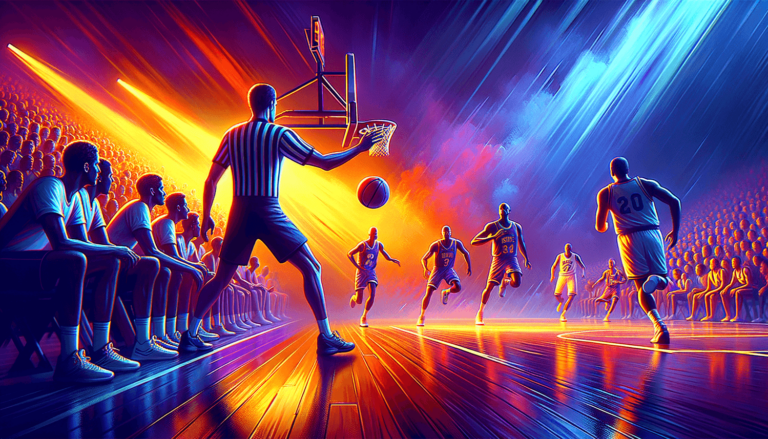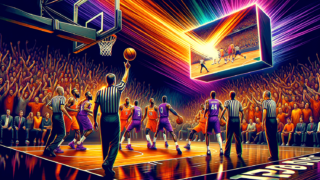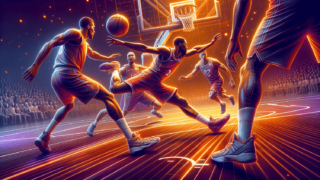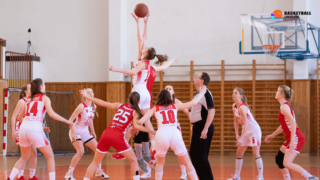
Last Two Minute Report in Basketball: What It Is and Why It Matters
Written by: Basketball Universe
Last updated:

Calling all basketball enthusiasts, it’s time to talk about a game-changing topic that has captivated the hearts and minds of fans and analysts alike – the Last Two Minute Report or L2M! If you’ve ever watched a nail-biting basketball game that came down to the wire, you know that every millisecond counts in those crucial final moments. The L2M report has become an influential factor in understanding how these intense moments unfold, dissecting the accuracy of the calls made by the officiating team. In this blog post, we’re about to dive into the nitty-gritty of the Last Two Minute Report, exploring what it is, the rationale behind it, and why it has become an indispensable tool in the world of basketball. Buckle up and get ready to become an L2M expert!
Last Two Minute Report in Basketball: What It Is and Why It Matters
The Last Two Minute Report (L2M) is a public review issued by the NBA shortly after the conclusion of games that have a point differential of three or fewer during the final two minutes of regulation, as well as during the entirety of any overtime periods. The goal is to provide transparency and accountability when it comes to referee decisions during high leverage moments. By disclosing officiating errors and correct decisions alike, the L2M serves to promote understanding, build trust among fans and teams, and enhance overall integrity within the league.
An In-depth Look at the Last Two Minute Report
The Last Two Minute Report or L2M is an exciting and, at times, controversial aspect of the basketball world. With transparency and accuracy being the primary goals, it has become an integral part of NBA basketball analysis. In this comprehensive guide, we will take you along a thrilling exploration of the L2M report’s origin, its impact on games, and its importance in the world of basketball. So, let’s dive right in!
Origin of the Last Two Minute Report
Although the concept of a detailed report focused on the final minutes of close games might seem like a novelty, it has its roots in a period of mounting tension and conflict within the NBA. Back in 2014, the league launched the L2M as a pilot project to foster transparency and review referee decisions in close games. Amid growing concerns over accurate officiating and demands for transparency, the L2M report aimed to alleviate tensions by examining the on-court rulings in those high-pressure scenarios. Initially, the project was promoted internally as a learning tool, but later transitioned into a public report to increase openness and trust within the basketball community.
Decoding the Last Two Minute Report
Dissecting the L2M report might seem daunting, but it’s essential to understand the categories, judgments, and notations that offer a treasure trove of information. We’ve broken it down into manageable sections to make the process more enjoyable!
Criteria for an L2M Report
For an L2M report to be prepared, a game must meet specific criteria. The contest must have a point differential of three points or fewer during the final two minutes of the fourth quarter or regulation play. Additionally, the entirety of any overtime periods will be included in the report, regardless of the final score.
Evaluating On-Court Decisions
L2M reports consider a wide range of on-court decisions, providing a meticulous analysis of key calls and non-calls. The focus is on whistle calls and adjudications concerning personal and shooting fouls, goaltending, violations (including out-of-bounds and traveling), and other critical plays. Every evaluated decision is classified as one of three assessments:
- Correct Call (CC): The on-court call was accurate
- Correct Non-Call (CN): Officials refrained from calling a foul or violation, which was the right decision
- Incorrect Call (IC) / Incorrect Non-Call (INC): An error was made, either through an erroneous whistle or a lack of one when it was warranted
Understanding L2M Notations
In an L2M report, multiple notations help describe the play’s context and provide clarity on the evaluation. Common notations include:
- Q, TIME: The quarter or overtime and time remaining when the play occurred
- CALL TYPE: The kind of call made, such as a foul or violation
- VIDEO: A hyperlink to the play within the NBA’s video database
- REVIEW DECISION: The final judgment given by the L2M (e.g., CC, IC, etc.)
- COMMENT: Additional context or explanation pertaining to the play
The Impact of the Last Two Minute Report on the Game
Purposeful or not, the L2M report has sent ripples throughout the NBA, impacting various aspects of the game—from player and coach reactions to trends in officiating. Let’s delve into some of the report’s most significant ramifications.
Transparency and Accountability
The L2M report has effectively peeled back the curtain on referee decisions, fostering greater transparency and trust between the NBA and its fan base, players, and coaches. By disclosing both correct and erroneous decisions, the L2M report bolsters the integrity of the league and promotes a broader understanding of the nuances of basketball rules.
Education and Improvement
The feedback provided by L2M reports affords referees an opportunity for growth and improvement. By analyzing mistakes and identifying areas requiring attention, officials can hone their skills and enhance game management. Furthermore, the explanations within the report also help players and coaches develop a deeper understanding of the game, allowing them to adjust strategies and plays accordingly.
Scrutiny and Controversy
The L2M report’s attempt to bring transparency to the league has also been met with criticism and controversy. By publicly highlighting controversial decisions, the report subjects referees to heightened scrutiny, often fueling heated reactions from players, coaches, and fans. Some argue that the L2M merely provides an avenue for controversy and debate, without offering any solutions for officiating errors during close games.
Why the Last Two Minute Report Matters in Basketball
Despite being a double-edged sword, the Last Two Minute Report has undeniably left its mark on the world of basketball. Here are a few reasons why the L2M has earned its place in modern basketball analysis.
An Enhancer of Trust and Understanding
As we’ve mentioned earlier, the L2M’s transparency contributes to building trust among all stakeholders—a vital component for the overall integrity of the league. Fans, players, and coaches can better comprehend the complexities and nuances of basketball rules, while the NBA demonstrates its commitment to transparency and accuracy.
A Tool for Analysis and Growth
Critics and pundits can use the L2M to dissect crucial game moments in tandem with examining referee calls. The insight provided allows for a comprehensive understanding of the game, opening up deeper conversations around strategy and officiating. As for referees, the L2M serves as a prime asset for continued learning and improvement.
A Platform for Discussion and Debate
Although the L2M report’s ability to spark controversy is perceived negatively by some, it undeniably generates conversations and debates about the game’s key moments. In an era where instant replays dominate the airwaves, L2M reports provide a structured approach to dissecting the decisions that influenced games’ outcomes. These healthy discussions are not only engaging but also enrich the basketball community’s understanding of the game and its intricacies.
Leaving a Lasting Impact: L2M in the Modern Basketball Landscape
The Last Two Minute Report has come a long way since its inception in 2014. While its primary purpose was to promote transparency and review referee decisions during close games, the reach and influence of L2M have undoubtedly extended beyond those goals. Today, L2M remains a contentious subject, but its impact on the landscape of the NBA is undeniable – from fostering trust and understanding to promoting improvement and education in the world of basketball. As the league continues to evolve and adapt, the L2M report will surely remain a crucial aspect of the modern basketball discussion.
Exploring Alternatives and the Future of L2M
As the Last Two Minute Report continues to evolve within the basketball landscape, there have been suggestions regarding alternative methods of addressing referee errors or enhancing the current L2M system. Let’s take a look at some of the ideas being discussed for the future of L2M in basketball.
Real-Time Replay and Video Assistant Referee
One potential solution to addressing referee errors during high-pressure moments is the implementation of a video assistant referee (VAR) or a real-time replay system. Already utilized in other sports, such as soccer and American football, VAR could provide a different approach to reviewing and rectifying on-court decisions. With this real-time support, refs can consult video replays and make more accurate decisions during the actual game, potentially reducing the post-game focus on the L2M report.
Expanding L2M to Cover Entire Games
Currently, the L2M report focuses exclusively on the final two minutes of close games and overtime periods. However, an alternative proposition is an expansion of these reports to encompass the entire game. By doing so, the transparency and accountability promoted by the L2M could be extended to cover all instances of officiating, providing more comprehensive analysis and insights.
Keeping the L2M Report Internal
Another possibility is reverting the report to its original internal status, focusing solely on the professional development of referees rather than public accountability. This change could potentially reduce controversy surrounding referee decisions while still allowing for concerted efforts towards improvement.
Emphasizing L2M Education and Improvements
Instead of solely highlighting errors or generating controversy, the focus of the L2M report could shift towards tangible referee improvements, emphasizing their growth and shared insights with coaches and players. By prioritizing education and development, the league could create a bridge between the officiating community, players, and coaches, consequently fostering a spirit of collaboration and understanding among all parties.
Conclusion
Ultimately, the Last Two Minute Report has undeniably asserted its significance in the world of basketball. While the report’s implementation, expansion, or modification could generate mixed reactions or further debate, its impact on the game remains indisputable. As we look towards the potential future of L2M within the sport, it seems evident that transparency, accountability, and an understanding of the nuances of basketball rules will remain at the core of any developments. The ongoing discussions surrounding its evolution serve to reinforce the L2M report’s role as a pivotal aspect within the ever-changing landscape of professional basketball.
FAQ: The Last Two Minute Report in Basketball
Our in-depth exploration of the Last Two Minute Report may have sparked some questions in your mind. In this FAQ section, we strive to address the most common questions related to the L2M report, offering clear and concise answers to reinforce your grasp on this fascinating aspect of professional basketball.
1. What is the purpose of the Last Two Minute Report?
The main objective of the L2M report is to promote transparency and accountability in officiating during critical moments in close NBA games. By providing a public review of calls made within the last two minutes of games with small point margins, the NBA aims to build trust among fans and teams while enhancing the understanding of basketball rules and officiating decisions.
2. When did the Last Two Minute Report start?
The L2M report was initially introduced by the NBA as a pilot project back in 2014. The league’s goal was to increase transparency and review referee decisions during close games, identifying areas for improvement and fostering learning within the officiating community.
3. How are games selected for the Last Two Minute Report?
A game becomes eligible for an L2M report if it features a point differential of three points or fewer during the final two minutes of the fourth quarter, or if the game extends to overtime periods. The entirety of the overtime is then included within the review, regardless of the final score.
4. Does the L2M report cover all on-court decisions?
The L2M report focuses primarily on critical plays, reviewing decisions related to personal fouls, shooting fouls, goaltending, violations, and other pivotal calls. It does not, however, address all on-court decisions or minute details.
5. Can the L2M report change the outcome of a game?
No, the Last Two Minute Report does not have the power to alter a game’s outcome. It only serves to provide transparency and accountability for officiating decisions made during the final moments of a close contest. The report does not impact the game’s result or any subsequent sanctioning or rulings.
6. How has the L2M impacted referees in the NBA?
In one regard, the L2M report has offered referees a valuable opportunity for growth and improvement. By analyzing errors and successful calls alike, officials can refine their decision-making capabilities. On the other hand, the public nature of the L2M has placed referees under increased scrutiny, sometimes generating tension and controversy around their calls and the game itself.
7. How can coaches and players benefit from the L2M reports?
Coaches and players can use the L2M report to gain insights into the intricacies of basketball rules and on-court decision-making. By understanding the reasoning behind referee calls, they can adapt their strategies, plays, and techniques more effectively, better preparing themselves for future contests.
8. Are L2M reports released for every NBA game?
No, L2M reports are only issued for games that meet specific criteria, which include a point differential of three or fewer during the last two minutes of regulation play, as well as any that go into overtime periods.
9. Can a coach or player request an L2M report?
Coaches and players do not have the authority to request an L2M report for a specific game. The NBA independently selects and prepares the reports for games that meet the designated criteria. However, teams can engage in dialogue with the NBA regarding officiating concerns, independent of the L2M report.
10. What other methods are being considered to improve officiating accuracy?
Some alternatives being discussed include the use of a video assistant referee (VAR) or real-time replay systems, expanding the L2M report to cover the entire game, reverting the L2M back to an internal process focused on referee development, or placing more emphasis on education and improvements within the officiating community.
Featured Posts
- No pillar pages found.





